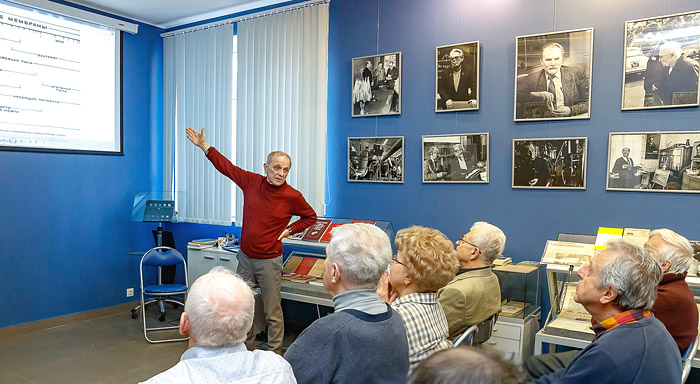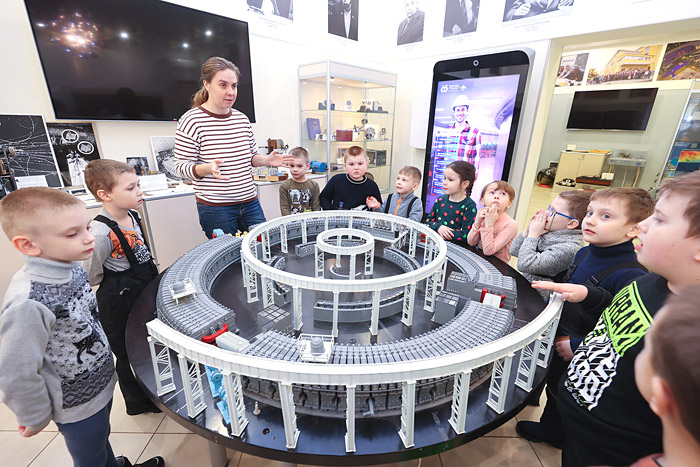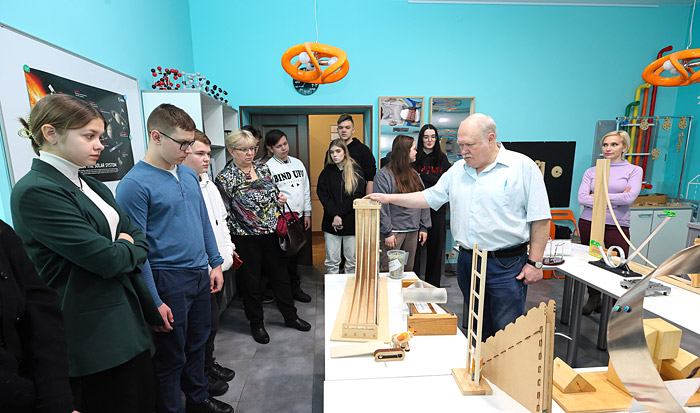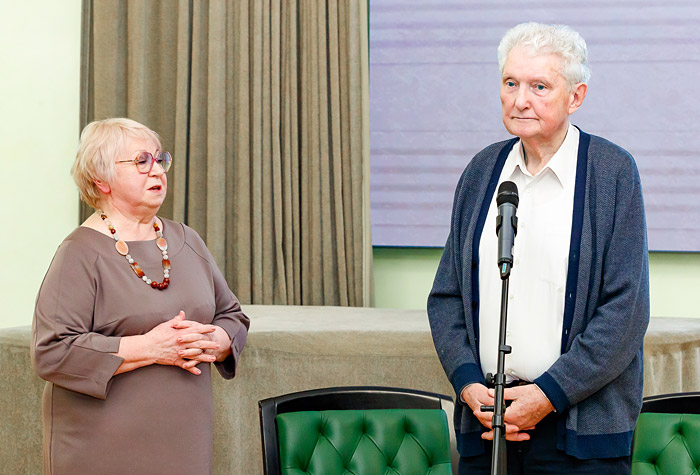
Electronic english version since 2022 |
The newspaper was founded in November 1957
| |
|
Number 30 (4678) |
Afterword for the anniversary
History, leisure, education
The idea of establishing the JINR Museum of History of Science and Technology occurred in the mid-1980s. It united a group of like-minded enthusiasts, the core of which included V.A.Nikitin, V.S.Shvanev and V.M.Zakharova. Veniamin Semenovich that by that time had ceased to be Head of the international department, at the first stage played an undoubtedly positive role in promoting this idea. The whole Institute knew him and it facilitated the passage of all bureaucratic procedures. And Vera Mikhailovna succeeded to establish contact with the Polytechnic Museum and enlist its support in the implementation of the plan and this is her great merit.
Through the efforts of the initiators, the Committee of Plenipotentiary Representatives of the Member States of the Institute at the session on 16-19 January, 1989, unanimously decided to establish the museum. Two weeks later, N.N.Bogolyubov signed an order to start the establishment of the museum and in particular, to approve the Museum Council of 14 people and its Chairman Vladimir Alekseevich Nikitin, one of the leading physicists of LHE.
The story of my appearance in the museum is quite romantic (but more on that another time). Most importantly, I am grateful to Volodya Nikitin that he offered me to become the director of the museum. This work has become a new milestone in my life. However, our museum was not born soon, because for more than a year, I could not get a room for it anywhere. And finally, Anna Solomonovna Girsheva that at that time was the editor of the institute newspaper "Dubna: science, commonwealth, progress" offered us two rooms of the former party committee of the Institute in the same wing of the building where the editorial office was located. One of them was full of metal shelves with books and periodicals and only after some time the third room - the hall that became an exhibition hall was vacated by a certain company, that is, at first, we had only one room. But it did not cool our enthusiasm with Vera Zakharova, especially since we were very lucky with our neighbors - the intelligent and friendly editorial office of the newspaper. These relations continued in the future, when the editorial board was headed by Evgeny Molchanov - the newspaper always responded to all significant museum events.
At this stage, the Polytechnic Museum gave us great support by offering to arrange an exhibition of JINR achievements in its building in Moscow, where they promised to provide two halls. Vera Zakharova and I began to prepare. It was necessary to collect exhibits, prepare exhibition equipment, arrange stands and negotiate with laboratories on the transfer of unique devices, models of basic facilities, parts of experimental devices. Perhaps, it was the most interesting time of our museum activity - we walked around the laboratories, talked to veterans, they shared their memories, told interesting stories. I remember Mikhail Grigorevich Meshcheryakov inviting V.A.Nikitin, V.M.Zakharova and me to LHTA and solemnly presented us with his gift to the museum - an emulsion chamber, on which the first physical experiment in Dubna had been carried out and the microscope presented to him by I.V.Kurchatov. This microscope was used to view emulsion plates with traces of particles emitted at different angles, scattered or born from the interaction of protons accelerated at the synchrocyclotron with photoemulsion nuclei. These two devices became the decoration of our exposition. The Laboratory of Neutron Physics responded with particular generosity, lending us, in particular, a working model of a pulsed reactor. By that time, the staff members of FLNP had established a wonderful laboratory museum and one of its founders Alexander Strelkov, spoke with passion and enthusiasm about ultracold neutrons and ended his story with a sealed tin can with the words: "This is what we gave Ilya Mikhailovich Frank - half a can of neutrons."
On 13 March, 1993, an exhibition of scientific and technological achievements of the Joint Institute for Nuclear Research in Dubna opened in two halls of the Polytechnic University with the participation of the press and television. This day became the museum's birthday. The exhibition turned out to be very informative both in terms of the abundance of unique exhibits and in terms of design. And of course, wonderful photographs by Yury Tumanov contributed to its success. In the future, both he and Head of the scientific and information department Boris Starchenko readily assisted us. The museum was very lucky that a wonderful master of artistic photography Yury Alexandrovich Tumanov worked at JINR that provided a unique opportunity for the design of expositions. (If the museum is finally given a large room, then it will be possible to present the work in all its glory.) Not a single scientific museum in the country has such an opportunity. A month after the end of the exhibition, we moved everything back and alas, most of the exhibits had to be returned: much did not fit in the museum.
From the moment the museum finally found its own premise, the most diverse events have been constantly held within its walls. They include informative lectures for schoolchildren given by specialists from the Polytechnic University, oral memoirs of JINR veterans and conversations about the history of science, in particular, a lecture by A.M.Baldin about Russian scientists, starting from the era of Peter the Great and a series of lectures by the staff members of the Institute for the History of Science and Technology of RAS "Science from antiquity to the present day". Many meetings were held with the editors of popular science journals and with individual scientists and individuals involved in the history of science. I especially remember the meeting with the famous intelligence officer V.B.Barkovsky that recruited a number of valuable agents in London and regularly, starting from October 1941, supplied from London the most valuable information about the English and then the American atomic project. That evening, the museum was packed to capacity and the driver got lost in Moscow and Barkovsky's arrival dragged on for an hour and a half. But no one left and no one regretted it, as it was extremely interesting.
But three activities carried out or initiated by the museum were the most important ones. In May 1996, the HISAP-96 symposium dedicated to the history of the Soviet nuclear project was held in the premises of the JINR Conference Hall. At that time, for the first time at such a high level of discussion, the Americans, the British, the French, the Germans and the representatives of other countries met with our physicists and historians of science - more than a hundred participants. This symposium had a great resonance - both in scientific circles and among the general public and at the same time the urgent need to continue such meetings was formulated. Three years later, the HISAP-99 conference was held in Austria and this time its name was not deciphered as HIstory of Soviet Atomic Project, but as HIStory of Atomic Projects. JINR was represented by T.D.Blokhintseva, M.G.Shafranova and the author of these lines. The soul and engine of both these conferences was a prominent theoretical physicist, an employee of the Kurchatov Institute Yury Vladimirovich Gaponov; but the contribution of our museum was essential to the organization of the first of them.
And in 2006, the museum hosted an exhibition dedicated to the 50th anniversary of JINR that included, in particular, posters prepared in cooperation with all laboratories, demonstrating the main scientific results obtained by them. And I will name, perhaps, the most significant event from a purely museum point of view. In October 2003, a three-day conference was held at the JINR Conference Hall called "History of science and museum affairs." About a hundred directors of museums - members of ICOM (International Council of Museums) gathered in Dubna from different cities of Russia. The first day was completely dedicated to learning about the history of JINR and its achievements. A.N.Sisakyan, Yu.Ts.Oganessian, D.I.Kazakov, V.M.Zhabitsky, Yu.S.Zamyatnin and other prominent JINR scientists addressed the participants. Since the vast majority of the participants were humanists, I asked all speakers to talk about science as simply as possible - like to small children. The performance of Yury Tsolakovich was especially bright. By the way, in order to be in time for the beginning, he left Obninsk at 4 o'clock in the morning. He said, "Imagine a droplet swelling on your nose; at some point there is a constriction and the droplet falls. This is how an unstable heavy nucleus decays." Of particular interest was Yu.S.Zamyatnin's story about his participation in the atomic project and about his classmate A.D.Sakharov. And after lunch, the participants of the conference were divided into three groups and the museum staff showed them the Institute's laboratories and accelerators, afterwards - the sights of Dubna.
The next two days were dedicated to the report of the Directorate of the ICOM of Russia, its discussion and the re-election of the President. G.G.Grigoryan again became President of ICOM. Necessary to say that what they saw and heard made a huge impression on the participants of the conference and many of them warmly thanked our Institute and the museum. Subsequently, unexpectedly for myself, I learned that, on the recommendation of the ICOM of Russia, I would be awarded the Medal of the Order "For Merit to the Fatherland". In the implementation of all these activities, as well as over the next many years, my faithful assistant and wonderful person Valentina Dmitrievna Efimova gave me great support.
Unfortunately, by the end of the 1990s, the museum was left by V.M.Zakharova, a real museum worker that received her second higher education at the Moscow Institute of History and Archives (MIHA), where she studied archival and museum business, the author of our first exposition and the first concept of our museum development that was highly appreciated by Director of the Polytechnic Museum G.G.Grigoryan. But there is no bad without good. A theoretical physicist, a graduate of Moscow State University A.A.Rastorguev that was carried away by the history of JINR, came to us from MLIT. The huge contribution of Alexander Alexandrovich to the scientific work of the museum, to the popularization of the work of JINR scientists is undoubted. These are articles, books and numerous booklets, lectures, of which the recent cycle dedicated to the history of discoveries of transuranium elements should be especially noted. By the way, Yu.Ts.Oganessian attended the lectures of this cycle and accompanied them with a very benevolent commentary. Readers can easily be convinced of the historical content of the texts and the literary talent of Rastorguev from his numerous publications on the Internet - on the resource proza.ru and other websites.

A.A.Rastorguev
In 2009, Nadezhda Kavalerova became Director of the museum. She enthusiastically undertook the expansion of its defining indicators - the working area, exposition and staff. Her energy and perseverance allowed the museum to be replenished with new premises, acquire its current beautiful view and significantly expand its field of activity. The most recent example is the book of D.I.Blokhintsev's diaries, perfectly published last year, the organization of the preparation and design of which was undertaken by Nadezhda Sergeevna. And of course, new young employees played an important role in these transformations. Anastasia Zlotnikova became not only the initiator of enriching the exposition with bright exhibits that clearly demonstrate the important laws of physics that of course, increased the attractiveness of the museum, but also the organizer of a number of exhibitions and exciting interactive events, including for children and also significantly expanded the museum's media capabilities, contributing, in particular, to the improvement and information replenishment of its website. Kirill Kozubsky did the labor-intensive and painstaking work on the analysis of the archive of M.G.Meshcheryakov and establishing his memorial office at MLIT. He also made the main contribution to the deciphering of the manuscripts of D.I.Blokhintsev's diaries, became the author of the permanent exhibition "Physicist's study of the 1960s" and finally, the most active guide. And as the popularity of the museum grows and the flow of tourists increases, there are more and more visitors and of course, all employees contribute to the daily work of conducting excursions.

Anastasia Zlotnikova, Kirill Kozubsky

All these years, the Council of the Museum, consisting of eminent physicists and headed by the most authoritative scientists, firstly, Vladimir Nikitin and afterwards, Evgeny Shabalin, supervised and provided moral support to the work.

Nadezhda Kavalerova, Genrikh Vardenga
All this was told by the speakers at the celebration of the 30th anniversary of the museum that was held on 18 April in the JINR Club of Scientists. I will not describe the content of this event, since the readers of the weekly "Dubna" at one time learnt about its celebration in a report. I would like to congratulate the museum staff on the high appraisal of its activities that was voiced in the speech of JINR Director Grigory Trubnikov and express my admiration for the current level of the museum's work with a brief dedication to the daughter of a noble sea captain, Director of our museum:
- Nadezhda Kavalerova,
Not at once my radar
I believed in a steep swing -
In your director's gift.
You have rammed through difficulties
Without losing face.
You have been a good captain
In a word, you are all in your father!
Genrikh VARDENGA